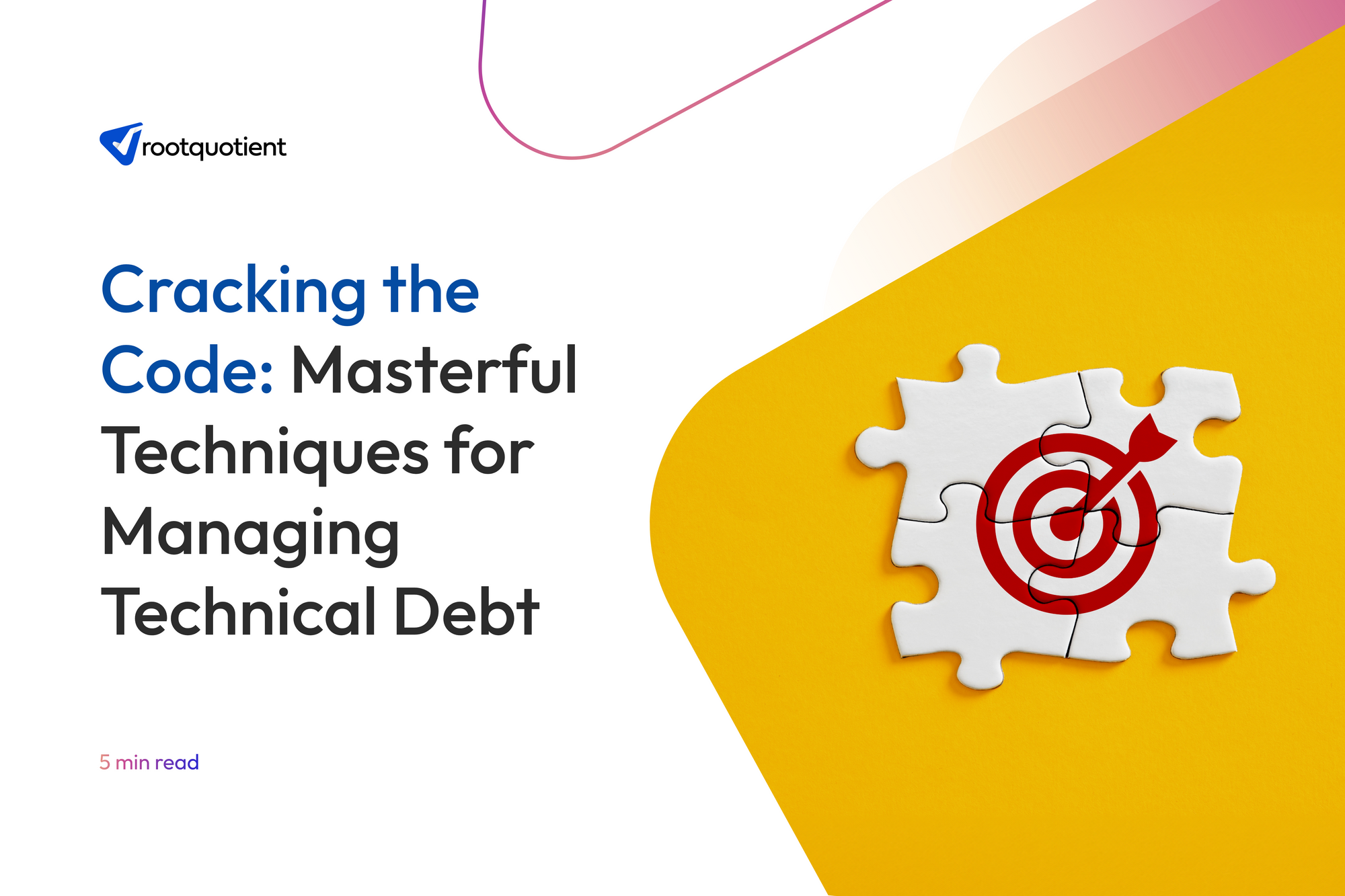Product Debt Management
Hidden product debt quietly erodes scalability, velocity, and user trust. Our product debt management consulting approach identifies and resolves technical, design, and strategic debt before it derails your roadmap.

How We Manage Product Debt Systematically
Strategic Layer Decomposition
We diagnose product debt across architecture, experience, and business logic, exposing patterns that impact delivery velocity, user retention, and decision quality.
Framework-Led Audits
Our audits map tech, design, and strategic debt using the RQ Product Debt Management Canvasprioritizing risk remediation based on roadmap impact.
Design Debt Resolution
We identify UI inconsistencies, interaction friction, and UX misalignment that contribute to user drop-offsthen refactor journeys without disrupting timelines.
Technical Debt Remediation
From brittle code to aging architecture, we isolate constraints that block performance, maintainability, or feature agility and guide modernization with minimal disruption.
Lifecycle-Aligned Prioritization
We don’t just fix what’s broken; we align remediation efforts with lifecycle stages, ensuring interventions support future readiness, not just short-term fixes.

Private Podcasting for Employee Communication
Clarity on Where Risk Lives
We make the invisible visible, exposing silent blockers buried in code, flows, or decisions that compound over time.
Lifecycle-Informed Action
We manage product debt as part of the lifecycle, mapping what to fix, when to fix it, and how it aligns with your roadmap.
No Disruption, Just Direction
Our methodology works around active roadmaps, minimizing rework while steering your team toward architectural, UX, and strategic integrity.
Cross-Functional Insight
We bring together product, engineering, and design teams around a shared lens for riskturning scattered symptoms into unified action.
Faster Recovery from
Product Drift
We help teams regain clarity, reduce late-stage churn, and rebuild product confidence across leadership, delivery, and customers.
Sustained Debt Prevention
We don’t just fix existing debt; we embed practices that prevent it from resurfacing, protecting product velocity and long-term scalability.
How We Help You Stay Ahead of Product Debt
Design Debt Reduction
We define product debt as any factor that limits scalability, performance, or user experience, spanning technical, design, and strategic dimensions.

Product Debt Management Canvas
Our Product Debt Management Canvas maps interconnected risks across architecture, UX, and decision frameworks, helping teams prioritize with full context.

Lifecycle-Integrated Remediation
Remediation is embedded into the product lifecycle, ensuring velocity is maintained while resolving critical issues.

Predictive Risk Management
We assess where debt is likely to emerge based on architecture, release patterns, and team workflows, enabling preventive action before it impacts delivery.

Scalable Foundations
By addressing structural weaknesses early, we establish a stable foundation for modular growth, innovation, and sustained product health.

Aligned Stakeholder Visibility
We provide a unified view of product debt across leadership, product, engineering, and design, ensuring decisions are informed, coordinated, and outcome-focused.


Conducting in-depth studies to understand user motivations, decision flows, and friction points that shape product engagement.

Analyzing current product experiences against industry best practices and competitor positioning to uncover improvement opportunities.

Structuring navigation, workflows, and interaction patterns that prioritize clarity, usability, and conversion

Creating behavioral personas and mapping end-to-end journeys to ensure every interaction feels intuitive and outcome-driven.
UX Validation

Using qualitative and quantitative feedback to validate design choices, identify early friction points, and optimize for product success.
Strengthening Product Stability & Delivery Speed
“We had experienced people on our project. They were notably fast and better than anyone we’d seen before. The team came on board quickly and excelled for their responsiveness, speed of development, and experience.”
“The team pays close attention to our requirements. Spend time discussing the project with Rootquotient; they’ve been helpful in guiding us”
“Rootquotient is reasonably priced, offers very good communication, and delivers solid work… I’m really happy with them; that’s why our relationship is ongoing”

How does the Product Debt Management Canvas improve risk visibility?
The Product Debt Management Canvas provides a structured way to surface hidden risks across technical, design, and strategic layers. It maps dependencies, highlights architecture debt resolution needs, identifies UX/UI debt remediation priorities, and tracks where brittle code refactoring or maintainability improvements will have the greatest impact.
At Rootquotient, we integrate this canvas into lifecycle-informed risk remediation so teams can see where product debt resides, how it affects delivery velocity, and the best sequence for roadmap-aligned debt prioritization. This approach enables informed, coordinated action that aligns product, engineering, and design functions.
What is architecture debt resolution and why is it critical?
Architecture debt resolution addresses foundational issues in system design that limit scalability, maintainability, or performance. Without resolving these bottlenecks, modular growth readiness, feature agility improvement, and architectural modernization planning become difficult or costly.
Rootquotient assesses current architecture for brittle structures, poor modularity, and scaling risks, then guides modernization with minimal disruption to ongoing development. In fintech architecture debt resolution projects, this often includes database optimization, refactoring service boundaries, and aligning systems with compliance needs.
How does UX/UI debt remediation improve user retention?
UX/UI debt remediation focuses on resolving visual inconsistencies, interaction friction, and navigation inefficiencies that harm onboarding flow optimization and user retention improvement. Rootquotient conducts design inconsistency resolution and user journey audits to identify pain points, then implements targeted fixes without disrupting release schedules. In healthtech UX debt remediation, for example, improving form clarity, mobile responsiveness, and accessibility can significantly boost patient engagement and reduce drop-offs in critical workflows.
How does brittle code refactoring enhance maintainability?
Brittle code refactoring replaces fragile, error-prone code with clean, modular structures that support maintainability improvement and performance bottleneck removal. Rootquotient’s phased technical debt cleanup approach ensures that refactoring is incremental, reducing the risk of introducing regressions. This process is often coupled with architectural modernization planning to ensure the codebase supports scalable product foundations and future innovation. For SaaS technical debt management, this may involve decoupling monolithic codebases, improving test coverage, and aligning APIs with modern standards.
How does roadmap-aligned debt prioritization prevent product drift?
Roadmap-aligned debt prioritization sequences remediation tasks in line with strategic goals, preventing product drift recovery efforts from being reactive. Rootquotient identifies which debts will most affect delivery velocity, modular growth readiness, and feature agility improvement, then schedules them alongside roadmap milestones. This coordination ensures debt work strengthens upcoming releases rather than delaying them, creating scalable product foundations for the future.
How does strategic decision debt mapping strengthen long-term scalability?
Strategic decision debt mapping identifies past choices – often in product positioning, architecture, or workflow logic, that now limit scalability or adaptability. Rootquotient audits these decisions as part of enterprise strategic debt audit engagements, assessing how they affect current and future roadmap plans. Addressing them may involve rethinking feature rollout strategies, updating lifecycle operating models, or changing governance practices to better support innovation.





